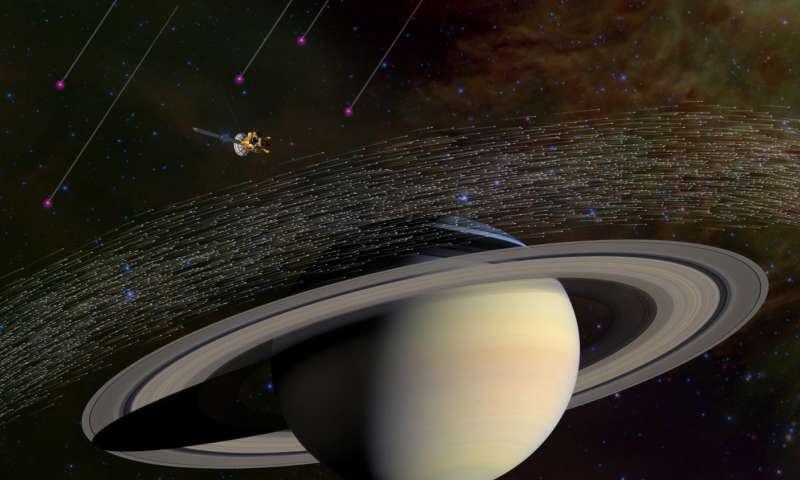NASA's Saturn probe detects interstellar dust
Fri 15 Apr 2016, 13:32:29

NASA's Cassini spacecraft orbiting Saturn has for the first time detected and analysed dust coming from beyond our solar system.
Cassini has been in orbit around Saturn since 2004, studying the giant planet, its rings and its moons. The spacecraft has also sampled millions of ice-rich dust grains with its cosmic dust analyser instrument.
The vast majority of the sampled grains originate from active jets that spray from the surface of Saturn's geologically active moon Enceladus, NASA said.
But among the myriad microscopic grains collected by Cassini, a special few - just 36 grains - stand out from the crowd. Scientists conclude these specks of material came from interstellar space - the space between the stars.
Alien dust in the solar system is not unanticipated. In the 1990s, the ESA/NASA Ulysses mission made the first in-situ observations of this material, which were later confirmed by NASA's Galileo spacecraft.
The dust was traced back to the local interstellar cloud: a nearly empty bubble of gas and dust that our solar system is travelling through with a distinct direction and speed.
"From that discovery, we always hoped we would be able to detect these interstellar interlopers at Saturn with Cassini. We knew that if we looked in the right direction, we should find them," said Nicolas Altobelli, Cassini
project scientist at ESA (European Space Agency) and lead author of the study.
"Indeed, on average, we have captured a few of these dust grains per year, travelling at high speed and on a specific path quite different from that of the usual icy grains we collect around Saturn," said Altobelli.
The tiny dust grains were speeding through the Saturn system at over 72,000 kilometres per hour, fast enough to avoid being trapped inside the solar system by the gravity of the Sun and its planets.
Importantly, unlike Ulysses and Galileo, Cassini was able to analyse the composition of the dust for the first time, showing it to be made of a very specific mixture of minerals, not ice.
The grains all had a surprisingly similar chemical make-up, containing major rock-forming elements like magnesium, silicon, iron and calcium in average cosmic proportions.
Conversely, more reactive elements like sulphur and carbon were found to be less abundant compared to their average cosmic abundance.
"Cosmic dust is produced when stars die, but with the vast range of types of stars in the universe, we naturally expected to encounter a huge range of dust types over the long period of our study," said Frank Postberg of the University of Heidelberg, co-investigator of Cassini's dust analyser. The research was published in the journal Science.
Cassini has been in orbit around Saturn since 2004, studying the giant planet, its rings and its moons. The spacecraft has also sampled millions of ice-rich dust grains with its cosmic dust analyser instrument.
The vast majority of the sampled grains originate from active jets that spray from the surface of Saturn's geologically active moon Enceladus, NASA said.
But among the myriad microscopic grains collected by Cassini, a special few - just 36 grains - stand out from the crowd. Scientists conclude these specks of material came from interstellar space - the space between the stars.
Alien dust in the solar system is not unanticipated. In the 1990s, the ESA/NASA Ulysses mission made the first in-situ observations of this material, which were later confirmed by NASA's Galileo spacecraft.
The dust was traced back to the local interstellar cloud: a nearly empty bubble of gas and dust that our solar system is travelling through with a distinct direction and speed.
"From that discovery, we always hoped we would be able to detect these interstellar interlopers at Saturn with Cassini. We knew that if we looked in the right direction, we should find them," said Nicolas Altobelli, Cassini
project scientist at ESA (European Space Agency) and lead author of the study.
"Indeed, on average, we have captured a few of these dust grains per year, travelling at high speed and on a specific path quite different from that of the usual icy grains we collect around Saturn," said Altobelli.
The tiny dust grains were speeding through the Saturn system at over 72,000 kilometres per hour, fast enough to avoid being trapped inside the solar system by the gravity of the Sun and its planets.
Importantly, unlike Ulysses and Galileo, Cassini was able to analyse the composition of the dust for the first time, showing it to be made of a very specific mixture of minerals, not ice.
The grains all had a surprisingly similar chemical make-up, containing major rock-forming elements like magnesium, silicon, iron and calcium in average cosmic proportions.
Conversely, more reactive elements like sulphur and carbon were found to be less abundant compared to their average cosmic abundance.
"Cosmic dust is produced when stars die, but with the vast range of types of stars in the universe, we naturally expected to encounter a huge range of dust types over the long period of our study," said Frank Postberg of the University of Heidelberg, co-investigator of Cassini's dust analyser. The research was published in the journal Science.
No Comments For This Post, Be first to write a Comment.
Most viewed from Specials
Most viewed from World
AIMIM News
Latest Urdu News
Most Viewed
May 26, 2020
Do you think Canada-India relations will improve under New PM Mark Carney?
Latest Videos View All
Like Us
Home
About Us
Advertise With Us
All Polls
Epaper Archives
Privacy Policy
Contact Us
Download Etemaad App
© 2025 Etemaad Daily News, All Rights Reserved.






















.jpg)
.jpg)
.jpg)

















